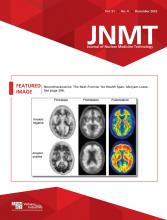RATIONALE/INTRODUCTION
Obstructive hydrocephalus is treated by several types of diversionary cerebrospinal fluid (CSF) shunts, such as ventriculoperitoneal, ventriculoatrial, ventriculopleural, or lumboperitoneal. Complications of a shunt include catheter blockage, infection, subdural or epidural hematomas, catheter disconnection, CSF pseudocyst, omental obstruction, or valve failure in the open position. Shunt patency and adequacy of CSF flow can be determined by performing a radionuclide shunt patency study.
INDICATIONS
Evaluation of shunt patency.
CONTRAINDICATIONS/TECHNICAL CONSTRAINTS
Inability of the patient to lie still.
Pregnancy/breastfeeding: Pregnancy must be excluded according to local institutional policy; if the patient is breastfeeding, appropriate radiation safety instructions should be provided.
Recent nuclear medicine study (radiopharmaceutical-dependent).
PATIENT PREPARATION/EDUCATION
The patient may eat and take medications as necessary before the procedure.
The patient should be lying flat for at least an hour before the study.
A focused history containing the following elements should be obtained:
○ History of neurologic procedures, including shunt.
○ History of hydrocephalus or seizures.
○ Symptoms of head pressure or pain, nausea, vomiting, visual disturbance.
○ Problems with balance or memory.
○ History of symptoms when upright.
○ Results of other diagnostic tests.
RADIOPHARMACEUTICAL IDENTITY, DOSE, AND ROUTE OF ADMINISTRATION
Radiopharmaceutical: 99mTc-pertechnetate.
Dose: 18.5 MBq (0.5 mCi) in 0.1 mL (range, 18.5–37 MBq [0.5–1.0 mCi] in 0.1 mL).
Route of administration: CSF shunt reservoir.
ACQUISITION PARAMETERS: PLANAR
Standard parameters:
○ Camera type: Large field of view.
○ Energy peak: 140 keV.
○ Energy window: 20%.
○ Collimator: Low-energy high-resolution.
○ Patient position: Supine with the head tilted to one side.
○ Camera position: Anterior.
○ Injection to imaging time: Immediately after injection.
○ Acquisition type: Dynamic and static.
○ Views: Anterior (to include shunt site and chest; static of abdomen at end of study).
○ Additional views: Per interpreting physician’s request.
○ Matrix: 128 × 128.
○ Number of views: 4.
○ Time per view: Dynamic, 10 s/frame for 20 min; static, 5 min/view.
Optional parameter:
○ Additional view time per projection: As requested, 5–10 min/view.
ACQUISITION INSTRUCTIONS
The patient is positioned completely flat (no pillow) on a stretcher with the capability to elevate the head. The patient will need to be repositioned semiupright midway through the study. Ideally, the patient should lie flat for 60 min before the tracer injection.
The tracer (0.1 mL or less) is injected into the shunt reservoir using an air-piston technique by a qualified health-care professional. The physician should also measure and record the CSF opening pressure before tracer injection. The physician should take care not to push on the reservoir after removing the butterfly needle.
Anterior dynamic images with the patient’s head tilted to one side to ensure the shunt is well visualized should begin immediately after injection. The field of view should include the injection site at the shunt reservoir and the tip of the distal tubing (right atrium or peritoneal cavity), if possible.
It is important for the patient to remain still, as even a slight change in position can cause significant change in attenuation. If the patient cannot remain still, the head should be immobilized.
A region of interest should be drawn around the reservoir during the acquisition to create a real-time time–activity curve. If activity is dropping slowly, the patient should be shifted to a semiupright position at 10 min. If activity drops quickly, the patient should be shifted to the semiupright position when about half the activity has left the reservoir.
A static anterior image of the abdomen is obtained on completion of the dynamic flow.
COMMON OPTIONS
Manual occlusion of the distal limb of the valve at the time of injection may be performed at the physician’s discretion to help reflux tracer into the ventricles to assess patency of the proximal limb of the tubing. Some shunts have a valve that can prevent this.
An occasional problem with CSF shunts is positional kinking of the tubing in the neck. If there is no flow in the distal tubing (or activity remains in the reservoir), patients should turn their head to the left for 1 min and to the right for 1 min during the dynamic acquisition. These head maneuvers should be performed if the activity displayed on the time–activity curve suddenly stops dropping (indicative of kinking).
If an intense area of focal uptake is seen on the static image of the abdomen (indicating a loculated collection of CSF fluid), SPECT/CT imaging should be performed immediately to locate the site precisely. 99mTc-pertechnetate is rapidly absorbed in the peritoneum.
If the time–activity curve is flat, air may have inadvertently been injected into the valve during the procedure, causing a temporary block of CSF flow due to surface tension. Flow will usually resume in 30 min, and an image of the abdomen should be acquired then.
PROCESSING INSTRUCTIONS
Sum the dynamic images and display for optimal visualization of the area of interest.
Scale planar images to visualize areas of interest accurately.
Display the time–activity curve, noting the time of positional changes.
PRECAUTIONS
Disruption of normal CSF flow physiology can be avoided by
○ Using minimal tracer volume (0.1 mL).
○ Avoiding removal of CSF fluid before injection of the tracer.
○ Avoiding letting any air enter the valve.
REFERENCES
- 1.
- 2.
- 3.







